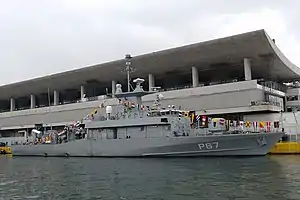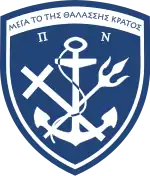Roussen-class fast attack craft
The Roussen class[1] is an eight-strong class of British-designed fast attack missile boats improved and customized for the Hellenic Navy, also known as Super Vita. The class is named after its lead ship, which in turn is named after Lt Nikolaos Roussen, a World War II submarines officer who was killed in the suppression of the Navy mutiny in April 1944.
 HS Roussen, P-67 in Piraeus during Saint Nicholas festival of 2009. | |
| Class overview | |
|---|---|
| Name: | Roussen, Super Vita |
| Builders: | |
| Operators: |
|
| Preceded by: | La Combattante IIIb |
| In commission: | 2005 - present day |
| Planned: | 8 |
| Building: | 1 |
| Completed: | 6 |
| Active: | 6 |
| General characteristics | |
| Type: | FACM |
| Displacement: | 580 tons / 668 tons fully loaded |
| Length: | 62 m |
| Beam: | 9.5 m |
| Draught: | 2.6 m |
| Propulsion: | 4 × MTU 16V595 TE90 diesel engines 23,500 hp |
| Speed: | 35 knots (65 km/h; 40 mph) |
| Complement: | 45 |
| Sensors and processing systems: | |
| Electronic warfare & decoys: |
|
| Armament: |
|
History
The modernization program of the Hellenic Navy in the late 1990s included the construction of three modern missile boats and was signed in January 2000. The construction took place at the Elefsis Shipyards, while Vosper Thornycroft (now BAE Systems Surface Ships) provided the necessary design, logistical support and equipment for the ships. On August, 2003 and September, 2008 options that provided the acquisition of four more vessels were activated with the last ship to be commissioned in 2015.
On September 25, 2008, a 299 million Euro contract was signed between the Greek State and the Elefsis Shipyards for the construction of the two remaining vessels of the class, P-78 and P-79. According to the contract, the delivery times of the two FACs were 46 months from the start of the contract for the first ship and 52 months for the second. Due to serious financial problems of the shipyards and the Greek state, there has been a 10 year delay in the construction of the two ships. In 2016 the Greek government decided that the Hellenic Navy should undertake the completion of the construction of the two vessels. The plan was that the two vessels should have been launched not later then 18 months after the signing of the contract and that they should have been delivered in the navy not later then 2019. In 2017, in a statement of Deputy Defense Minister D. Vitsas there were hopes that the construction would have finished in mid 2018.[2] Finally, on June 1, 2018, the launch of the 6th Super Vita P-78 took place at the Elefsina Shipyards.[3][4] With a ceremony held 28th July 2020, the 6th vessel was officially commissioned into the Hellenic Navy.[5] The 7th vessel was launched on 5 August 2020 and commissioning is probably not going to happen before 2021.[6] An eighth ship was revealed in January 2021.[7]
In September 2020, the UK offered to build eight boats of the same design for Ukraine.[8]
Design
The plans of the Roussen Class missile boats are based on smaller Vita class boats serving in the navies of Qatar, as well as similar size vessels built for Oman and other countries. The hull is made of steel and the superstructure is made of Aluminum, while the company Vosper Thornycroft (now BAE Systems Surface Ships) provides the electricity transmission system, the management board, electrical equipment and systems countermeasures.
Weapons and electronics
The main armament of the ships are eight Exocet MM40 Block II/III anti-ship missiles with a range of up to 70/180 km respectively. They are complemented by an Otobreda 76 mm naval gun in the bow and two smaller 30mm cannons as secondary weapons located on the ships' superstructure. The vessel's primary anti-air and anti-missile weapon is the RIM-116 RAM missile system which comprises an onboard Mk-31 launcher with 21 projectiles, as well as the DR3000 electronic support measures system and the Mk36 SRBOC decoy launcher.[9]
The sensor suite responsible for the timely identification and homing of surface and air targets includes the MW08 3D G-band surveillance radar, the Mirador electro-optical target tracker and the Scout MkII low probability of intercept radar which is being controlled by the TACTICOS combat management system.
Ships
The ships of this class are named after junior officers of the Hellenic Navy who have been killed in action. They are:[10]
| Pennant number |
Greek name |
Transliterated name |
Namesake | Builder | Launched | Commissioned | Status |
|---|---|---|---|---|---|---|---|
| P 67 | Υποπλοίαρχος Ρουσσέν | Ypoploiarchos Roussen | Lieutenant Nikolaos Roussen, killed during the suppression of the naval mutiny of 1944. | Elefsis Shipyards | 12 November 2002 | 20 December 2005 | In service (2020) |
| P 68 | Υποπλοίαρχος Δανιόλος | Ypoploiarchos Daniolos | Lieutenant Antonios Daniolos, executive officer of the submarine Triton, killed when the ship was sunk by the Germans on 16 November 1942 | Elefsis Shipyards | 8 July 2003 | 22 February 2006 | In service (2020) |
| P 69 | Υποπλοίαρχος Κρυσταλλίδης | Ypoploiarchos Krystallidis | Lieutenant Vyron Kristallidis, crew member of the auxiliary ship Pleias, killed when the ship was sunk by the Germans on 22 April 1941 | Elefsis Shipyards | 6 April 2004 | 8 May 2006 | In service (2020) |
| P 70 | Υποπλοίαρχος Γρηγορόπουλος | Ypoploiarchos Grigoropoulos | Lieutenant Michail Grigoropoulos, executive officer of the destroyer Vasilissa Olga, killed when the ship was sunk by the Germans on 26 September 1943 | Elefsis Shipyards | 20 December 2005 | 1 October 2010 | In service (2020) |
| P 71 | Υποπλοίαρχος Ρίτσος | Ypoploiarchos Ritsos | Lieutenant Nikolaos Ritsos, killed on 16 November 1912 as commander of a naval infantry company during the capture of Chios from the Ottomans | Elefsis Shipyards | 6 October 2006 | 10 January 2015 | In service (2020) |
| P 78 | Υποπλοίαρχος Καραθανάσης | Ypoploiarchos Karathanasis | Lieutenant Christodoulos Karathanasis, killed on 31 January 1996, during the Imia crisis, when the AB 212 helicopter PN 21 crashed into the sea | Elefsis Shipyards | 1 June 2018 | 28 July 2020[11] | In service (2020) |
| P 79 | Υποπλοίαρχος Βλαχάκος | Ypoploiarchos Vlachakos | Lieutenant Panagiotis Vlachakos, killed on 31 January 1996, during the Imia crisis, when the AB 212 helicopter PN 21 crashed into the sea | Elefsis Shipyards | 5 August 2020 | Launched (2020) | |
| P ? | Υποπλοίαρχος Γιαλοψός | Ypoploiarchos Gialopsos | Captain Hector Gialopsos, killed on 31 January 1996, during the Imia crisis, when the AB 212 helicopter PN 21 crashed into the sea | Elefsis Shipyards | |||
Similar ships
Gallery
.jpg.webp) Adm. James G. Foggo III, commander, U.S. Naval Forces Europe-Africa and commander, Allied Joint Force Command Naples, Italy, returns a salute from crewmembers aboard Hellenic Navy Roussen-class fast attack craft HS P-71 Ritsos as he arrives at a Salamis Naval Base in Greece, May 10, 2018
Adm. James G. Foggo III, commander, U.S. Naval Forces Europe-Africa and commander, Allied Joint Force Command Naples, Italy, returns a salute from crewmembers aboard Hellenic Navy Roussen-class fast attack craft HS P-71 Ritsos as he arrives at a Salamis Naval Base in Greece, May 10, 2018
References
- Information and photos about the ships, Hellenic Navy official website (in Greek)
- Statement by the Deputy Minister of Defense Dimitris Vitsas about the progress of the construction of the two vessels while he visited Elefsis Shipyards on 28 July 2017
- Drone video of the launching of P-78 Karathanasis
- Article in Greek news site "Iefimerida.gr" about the launching of P-78, 28/07/2018
- Με το όνομα του ήρωα των Ιμίων Καραθανάση, εντάχθηκε στο Πολεμικό Ναυτικό η νέα πυραυλάκατος
- Article in Greek online defence magazine defencereview.gr 26 April 2020 (in Greek)
- "Three Greek Navy Ships Named After Imia Martyrs". Greek City Times. January 2021. Retrieved 6 February 2021.
- "Вісім ракетних катерів за ціною корвета: чи варто приймати пропозицію Великобританії" (in Ukrainian). Defense Express. 12 September 2020. Retrieved 18 September 2020.
- https://www.youtube.com/watch?v=ZM2jEUmSDdo
- "Πυραυλάκατοι (ΤΠΚ) τύπου ΡΟΥΣΣΕΝ" (in Greek). Hellenic Navy. Retrieved 15 June 2018.
- Delivery of the 6th Super Vita class fast attack craft, article in defencereview.gr (28 July 2020) (in Greek)
Sources
- "Roussen Class (62m Super Vita) Fast Attack Missile Craft, Greece". Naval-Technology.com. SPG Media Limited. Retrieved January 29, 2009.
- Wertheim, Eric (2007). The Naval Institute Guide to Combat Fleets of the World: Their Ships, Aircraft, and Systems. Naval Institute Press. p. 267.

